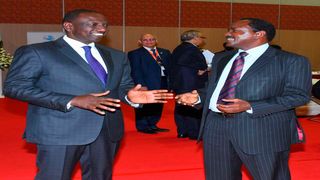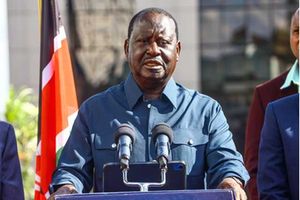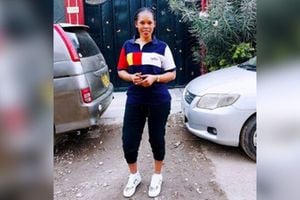
Deputy President William Ruto chats with former Vice President Kalonzo Musyoka.
| File | DPPSPolitics
Premium
Ruto, Kalonzo gain in latest voter listing
The game of numbers has officially kicked off after the electoral commission added to the roll of voters 2.55 million new names, bringing the total number of eligible voters to 22.15 million.
The 2.55 million is way below the Independent Electoral and Boundaries Commission (IEBC) target of six million new voters in its mass registration drive last October, and another one that ended last Sunday.
IEBC will now have to subject the voter register to a mandatory audit to weed out dead voters, double registrations, and mismatch in the registrations, before gazetting the official and final list of the register of voters.
The commission has until today to engage a reputable audit firm, a deadline the IEBC is likely to miss after what it says was a non-responsive bid, but which, they say, is unlikely to affect other timelines, if a firm is procured by end-month.
But for Deputy President William Ruto, Azimio la Umoja boss Raila Odinga, and the One Kenya Alliance of Kalonzo Musyoka, the focus on numbers starts right away, with key teams crunching away and playing out scenarios to refocus their campaigns ahead of the August poll.
In the updated list, DP Ruto’s Rift Valley region leads with 5.3 million new voters, followed by Eastern (3.3 million), Central (3.154 million), Western (2.71 million), Nyanza (2.563 million), Nairobi (2.505 million), Coast (1.953 million), with North Eastern trailing at 614, 999.

Plagued by voter apathy and the fact that the region is unlikely to have a frontrunner in the race for the first time since 1992, President Kenyatta’s restive Mt Kenya recorded one of the lowest number of new voters in the just-concluded exercise, compared to its target.
Mt Kenya registered 244,243 new voters, to hit 3.15 million total voters.
The numbers were way below the IEBC target of nearly 1.5 million and for the DP, this kind of voter apathy in President Kenyatta’s backyard is worrying, especially given that the region gave the Jubilee pair over 50 per cent of the votes they got in 2013 and 2017. Of the 6.2 million Uhuru-Ruto secured in 2013, 3.2 million (52 percent) came from Mt Kenya counties as well as Laikipia and Nakuru in the Rift, but which predominantly votes as a bloc.
In 2017, this percentage remained almost constant as the region handed the Jubilee pair 4.1 million (50 per cent) votes of the 8.2 million they amassed. Mr Odinga, backed by the President himself and his key allies, has now been eyeing the region, hoping to get a slice of the vote-rich bloc.
Based on these figures, DP Ruto’s win matrix is tied at the hip with a high voter turnout in Mt Kenya, as a vote for any other candidate other than him in the mountain, will be at his expense.
Anti-Odinga sentiment
Mr Odinga’s strategists have suggested that the former premier is targeting at least 30 per cent of the votes in the region, well over 1.5 million. With the anti-Odinga sentiment that the Jubilee pair used to rally the Mt Kenya bloc to come out and vote for them in 2017 and 2013 slowly fading away, amid a concerted effort by the Head of State to market Mr Odinga, the Ruto matrix at the mountain gets even more complicated.
In Rift Valley, which recorded the highest new number of voters per region, the DP has his hopes intact. With 694,449 new votes, hitting 5.34 million total number of votes, the region is the single biggest in terms of votes.
In 2017, Mr Odinga polled 24 per cent, with his allies now targeting at least 30 per cent, or about 1.8 million votes, even as the DP works to retain the region as a bloc.
In Ukambani, where Mr Odinga’s Azimio is courting kingpin Kalonzo Musyoka of Wiper and his One Kenya Alliance, the question is whether the former vice-president still holds as big enough a sway as he did in the two previous polls.
In fact, political commentators see Mr Musyoka as a decider whether he chooses to run alone or casts his lot with either of the top candidates.
In 2017, Kitui, Makueni and Machakos counties handed Mr Odinga nearly one million votes, pushing him to 44.74 per cent of the national vote. Kitui, Machakos and Makueni collectively gave Mr Odinga 768,025 votes in 2013 and 968,437 in 2017.
The region now has 1.69 million votes, after adding 178,927 in the new voter registration period.
For Mr Odinga, being joined by Mr Musyoka will be a big plus in the race for the 50 per cent plus one vote required to win the presidency in the first round.
In Coast, the battle is on for the 1.95 million voters, after the region added 240,377 new members to its list. Firmly behind Mr Odinga in 2007, 2013 and 2017, Coast region raised its numbers for Jubilee in 2017 to hit 258,000, up from 158,000 five years earlier when Mr Odinga polled 612,057 votes. The DP is looking to double President Kenyatta’s 2017 performance at the expense of his rival, Mr Odinga, who still holds sway in the region.
In Western, where the DP has recently won over regional bigwigs Musalia Mudavadi and Moses Wetang’ula, the battle is for its impressive 2.71 million votes, which is often tallied with those of Trans Nzoia, which now has 395,741 votes, as they often vote in a bloc.
With 3.1 million votes, Western is now a battleground region with analysts seeing Mr Odinga as having the upper hand.
The Orange Democratic Movement boss has in his corner all governors bar Trans Nzoia’s Patrick Khaemba, an ally of Mr Wetang’ula. Ex-Rift Valley regional commissioner George Natembeya, who is firmly in Mr Odinga’s corner, is seen as the frontrunner in the race to replace Mr Khaemba.
In Mr Odinga’s Nyanza backyard, now with 2.563 million votes, DP Ruto, it seems, is aiming to hive off just a fraction, with his constant focus on Kuria in Migori as well as Gusiiland counties of Kisii and Nyamira.
At the same time, IEBC registered 2,959 new voters and serviced 2,964 transfer requests in Uganda, Tanzania, Rwanda, Burundi, South Africa, the UAE, the USA, United Kingdom, Canada, Qatar and South Sudan.
The diaspora is listed as the 291st constituency and are only allowed to vote for President.
Kenyans still have a chance to enlist at IEBC offices in all the 290 constituencies. The commission said it will have three biometric voter registration kits per constituency.
[email protected]
Additional reporting by Onyango K’onyango





